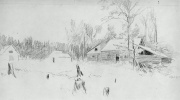Difference between revisions of "Black chalk"
Jump to navigation
Jump to search
(username removed) |
(username removed) |
||
| Line 2: | Line 2: | ||
== Description == | == Description == | ||
| − | An old name for a soft, blue-black variety of a clay formed from aluminum containing [http://cameo.mfa.org/materials/fullrecord.asp?name=slate slate]. Black chalk obtains its color from impurities of [http://cameo.mfa.org/materials/fullrecord.asp?name=carbon carbon], [http://cameo.mfa.org/materials/fullrecord.asp?name=iron | + | An old name for a soft, blue-black variety of a clay formed from aluminum containing [http://cameo.mfa.org/materials/fullrecord.asp?name=slate slate]. Black chalk obtains its color from impurities of [http://cameo.mfa.org/materials/fullrecord.asp?name=carbon carbon], [http://cameo.mfa.org/materials/fullrecord.asp?name=iron%20oxide%20black black iron oxide], or [http://cameo.mfa.org/materials/fullrecord.asp?name=manganese%20oxide manganese oxide]. It was sometimes used as a crayon or writing tool, especially since the Rennaisance. Black chalk was mined in Thuringia, parts of France and Andalucia. Sometimes graphite was also referred to as black chalk. |
[[File:67.698-C27123.jpg|thumb|]] | [[File:67.698-C27123.jpg|thumb|]] | ||
| Line 30: | Line 30: | ||
== Authority == | == Authority == | ||
| − | * | + | * R. J. Gettens, G.L. Stout, ''Painting Materials, A Short Encyclopaedia'', Dover Publications, New York, 1966 |
| − | * | + | * Ralph Mayer, ''A Dictionary of Art Terms and Techniques'', Harper and Row Publishers, New York, 1969 (also 1945 printing) |
| − | * | + | * R.D. Harley, ''Artists' Pigments c. 1600-1835'', Butterworth Scientific, London, 1982 |
* ''The Dictionary of Art'', Grove's Dictionaries Inc., New York, 1996 Comment: "Pigments" and "Chalk" | * ''The Dictionary of Art'', Grove's Dictionaries Inc., New York, 1996 Comment: "Pigments" and "Chalk" | ||
| − | * | + | * Susan E. Schur, Conservation Terminology: A review of Past & Current Nomenclature of Materials, ''Technology and Conservation'', Spring (p.34-39); Summer (p.35-38); Fall (p.25-36), 1985 |
| − | * | + | * Monona Rossol, ''The Artist's Complete Health and Safety Guide'', Allworth Press, New York, 1994 |
* Art and Architecture Thesaurus Online, http://www.getty.edu/research/tools/vocabulary/aat/, J. Paul Getty Trust, Los Angeles, 2000 | * Art and Architecture Thesaurus Online, http://www.getty.edu/research/tools/vocabulary/aat/, J. Paul Getty Trust, Los Angeles, 2000 | ||
Revision as of 06:51, 24 July 2013
Description
An old name for a soft, blue-black variety of a clay formed from aluminum containing slate. Black chalk obtains its color from impurities of carbon, black iron oxide, or manganese oxide. It was sometimes used as a crayon or writing tool, especially since the Rennaisance. Black chalk was mined in Thuringia, parts of France and Andalucia. Sometimes graphite was also referred to as black chalk.
Synonyms and Related Terms
craie noire (Fr.); lapiz negro (Esp.); grafite (It.); piombaggine (It.); mineral black; black earth; Italian chalk
Hazards and Safety
No significant hazards.
Additional Information
J.Winter, "The Characterization of Pigments Based on Carbon" Studies in Conservation 28:49-66, 1983.
Additional Images
Authority
- R. J. Gettens, G.L. Stout, Painting Materials, A Short Encyclopaedia, Dover Publications, New York, 1966
- Ralph Mayer, A Dictionary of Art Terms and Techniques, Harper and Row Publishers, New York, 1969 (also 1945 printing)
- R.D. Harley, Artists' Pigments c. 1600-1835, Butterworth Scientific, London, 1982
- The Dictionary of Art, Grove's Dictionaries Inc., New York, 1996 Comment: "Pigments" and "Chalk"
- Susan E. Schur, Conservation Terminology: A review of Past & Current Nomenclature of Materials, Technology and Conservation, Spring (p.34-39); Summer (p.35-38); Fall (p.25-36), 1985
- Monona Rossol, The Artist's Complete Health and Safety Guide, Allworth Press, New York, 1994
- Art and Architecture Thesaurus Online, http://www.getty.edu/research/tools/vocabulary/aat/, J. Paul Getty Trust, Los Angeles, 2000






